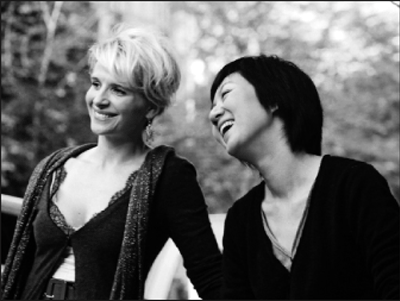By Leonard Quart
Minimalist twist on the 1956 children’s classic
Favorites at international film festivals, the severely minimalist films of Taiwanese director Hou Hsiao-hsien have typically received only short runs in New York theaters. Many of his movies deal with Taiwanese history of the past century. “A City of Sadness” (1989), for example, portrays a family caught in conflicts between the local Taiwanese and the newly arrived Chinese Nationalist governments after World War II.
Set in Paris, “Flight of the Red Balloon,” approaches its setting in an oblique manner. Hsiao-hsien has taken on Albert Lamorisse’s 1956 half-hour children’s classic, “The Red Balloon,” about a solitary little boy who is followed around the cobblestone Parisian streets by a magical red balloon (a metaphor for escape from constraint and destructive behavior) and attempts to have it serve his own vision.
Little happens in Hsiao-hsien’s plotless film, which depicts in extremely long takes the day-to-day activities of a puppeteer, Suzanne (a radiant Juliette Binoche), her seven-year-old son, Simon (Simon Iteanu), and his new babysitter—a filmmaking student from Beijing, Song Fang (the director Hsiao-hsien’s alter-ego). They live in a claustrophobic, disordered apartment (part of the house that Suzanne has inherited) that feels charmingly chaotic rather than oppressive. Viewers observe Song making pancakes, Suzanne chatting with piano movers as she anxiously searches for a tenancy agreement lost in the apartment’s mess, and Song and Simon leaving the apartment and playing pinball and video games in cafés. Suzanne performs vocals for her puppetry shows (a subject that looms large in Hsiao-hsien’s memories, as it was the central focus of his film “The Puppet Master”). Song, who carries her camera everywhere shooting street scenes, casts Simon in her own homage to “The Red Balloon.”
Suzanne can be warm and self-consciously sensitive with Simon, but remains far from a model mother. She is a woman with a thoroughly tangled personal life. Her new husband/partner, Simon’s father, a novelist, has been out of reach in Montreal for a long time, and her elder daughter from another partner lives with Suzanne’s father in Brussels, and their visits are infrequent. Suzanne is also constantly harried and frazzled with a career whose demands make her at times distracted. In the midst of all this turmoil, which includes an angry fight with the couple renting the downstairs apartment for non-payment, the emotionally high-pitched Suzanne—who oscillates between screaming, laughing, and expressing tenderness—struggles to do what is right for Simon.
Hsiao-hsien began the filming of “The Flight of the Red Balloon” with a full script entirely devoid of dialogue. The actors improvised their roles. A gifted actress like Binoche can take her part and construct a layered, totally alive presence that is riveting to watch. The young child actor, however, has problems conveying much more than his obvious intelligence and loneliness. Song renders an affect-less delivery, resulting in an unreadable character. Consequently, the characters themselves are of little interest.
What gives the film some distinction is not only Binoche’s performance, but also Hsiao-hsien’s fluid hand-held shots, which evoke the rhythms of everyday life in Paris, including street noise, traffic, and strangers gathered in cafés. The movie offers a few tourist sights—boats on the Seine, Luxembourg Gardens—but Hsiao-hsien is more interested in shooting from trains and capturing reflections in café windows than in relaying the oft-depicted grandeur of Paris.
One of the film’s primary flaws lies with its eponymous subject. Although the red balloon is featured at the movie’s opening, it makes only brief appearances until the movie’s end, when it floats over the roofs of Paris in a conventionally majestic long shot. As used by Hsiao-hsien, the balloon is more of a stylistic device than a metaphor that would underscore his film with a poetic lift. While “Flight of the Red Balloon” is the work of an artist in possession of a singular style and vision, it is too thin and insufficiently revelatory a film to be fully successful.





































